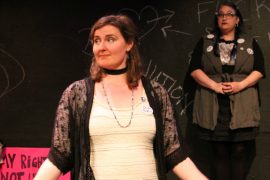Relational Voter Program Seeks To Increase Female Turnout In Midterm Elections
By Hywania Thompson
When we’re looking for a new car, appliances, the best day care or a fitness studio, who do we turn to? We ask our family, friends and coworkers for recommendations. We trust information from these people because we know them. This is the idea behind the Relational Voter Program—an effort aimed at increasing the number of women voters through the power of personal relationships.
The Wisconsin Alliance for Women’s Health is leading the effort and working with other organizations—Mid-Day Women’s Alliance, Wisconsin Breast Cancer Coalition and Zonta Club of Madison—on the program. The Wisconsin Alliance tested the idea in 2016. Founder and executive director Sara Finger says relying on personal relationships is nothing new. “The idea of the power of the personal connection of relationships and the trust you have with someone you know is as old as time,” says Finger. Over the years, we’ve seen “traditional” get out the vote efforts—social media, TV ads, radio ads. However, Finger says those mechanisms haven’t necessarily been effective.
Only 56 percent of eligible Wisconsin women voted in the 2010 midterm election. The same percentage held in the 2014 midterm election. And, Finger says, the largest group of people who didn’t vote in the state in 2016 were white, unmarried women.
“What we’re seeing as a society right now is that policy and decisions have been happening to women instead of with women,” she says. “One of the most powerful ways to have things happen with you is to show up and be part of the decision.”
Women often face barriers when it comes to voting, such as having to care for parents and children or having feelings of intimidation, apathy and frustration with the system. Finger hopes the Relational Voter Program can help remove those barriers. “Having someone in your life that you trust to remind you of how important that is and together, collectively, share a voice—but doing so with your individual vote—is really powerful,” she says.
How It Works
The Relational Voter Program is simple. You sign up to become a leader on the program’s website. During sign up, you include names of women in your network who you believe aren’t registered to vote or haven’t voted in recent elections. Organizers say that ideally your list (which is never released publicly) should include people who trust you and would accept your help to get them to the polls. A database pulls the information you entered and creates a customized report. Then a “coach” from the Wisconsin Alliance for Women’s Health contacts you to give you the report, as well as resources to reach out to the people on your list. The coach works with you through the election to help you support your network. And no need to worry about the organization keeping the information in its database. Finger says once your report is pulled, the information is deleted from the database. The alliance hopes to have 100 people sign up as voting project leaders, with a goal to get 65 percent of Wisconsin women out to vote in 2018.
T.R. Williams is a Relational Voter Program leader. She learned about the program at a summit hosted by the alliance earlier this year. Williams had been invited to speak at the summit and was struck by the call to action. “The [Relational Voter Program] was presented as a way to affect change in a practical and real way among those that are sometimes the hardest to reach—family and close friends. So I stepped up. Answered the call. It was the least I could do,” Williams says. She says those working in the public sector doing good work, who then have to go home to their families with something left, often get tunnel vision and experience compassion fatigue. She says she’s been guilty of both, but the Relational Voter Program offers an easy lift. “The idea that policy, legal and health change could be as simple as getting those who I loved, those who I had memories with, to vote—intentionally, strategically, with purpose and vigor struck me as doable and necessary. There was no other choice,” Williams says.
Women Candidates
The wave of female candidates running for office across the nation has washed over Wisconsin as well. As of BRAVA’s press time, Wisconsin’s Aug. 14 primary election included 11 women on the statewide ballot running for governor, lieutenant governor, secretary of state, state treasurer and U.S. senator. Dozens more women are vying to represent districts in the U.S. Congress and state senate and assembly, although none are in Dane County.
With the Wisconsin primary coming up on Aug. 14 and the general election on Nov. 6, the alliance’s Finger wants people to understand the power of every election and that every election has consequences.
“I just hope that in a world we’re living in where these divides that exist between us because of the state of our political system, that we can all agree that no matter where you are on the political spectrum, there’s incredible power in exercising our right to vote.”
Learn more about the upcoming elections and the Relational Voter Program at asklearnvote.org.




